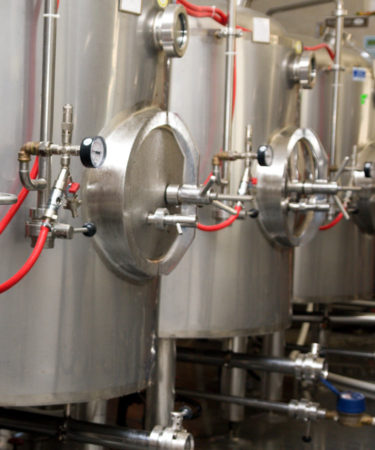Hundreds of craft breweries are expected to close by the end of 2018, according to Brewers Association chief economist Bart Watson. But the presence of “distressed breweries” is not necessarily a sign of hard times; it’s a sign of a maturing industry, and one that has become increasingly competitive.
According to Watson, who spoke at the California Craft Brewer Summit earlier this month, breweries in danger of shuttering could reach 300 this year, and 500 “in the next couple of years,” Brewbound reports.
From well-known national and regional brands like Green Flash, Redhook, and Smuttynose to small brewpubs like Gallery Brewery in Portland, Mich., which closed this summer, distressed breweries are giving up their brewhouses to the auction block.
“It’s not uncommon to see this in industries. It’s certainly a new development in the past several years in the brewing industry, but I don’t think it’s a sign of worry from a wise business person’s perspective,” Jack O’Connor, an associate who specializes in reorganizations for Sugar Felsenthal Grais & Helsinger LLP, told Brewbound.
And, O’Connor added, the steel doesn’t sit unused — it provides opportunity for future, potentially better brewing.
This may be scary for mid-tier beer industry members, but it’s normal. Beer is a business. With nearly 7,000 breweries expected to be in operation by the end of the year, closings concurrent with that growth are only natural for a burgeoning industry. If every brewery that opened were successful, we wouldn’t see the quality and innovation coming out of craft beer that we see today. Chances are, there’d be a lot more bad beer out there.
MillerCoors and ABI Duke It Out Over Diet Beer
Just a month after MillerCoors announced it would be ending production of its millennial-facing fruited light lager, Two Hats, the company announced on Sept. 10 that it will “test a new craft light lager” in four U.S. markets next year. Called Saint Archer Gold, it will be brewed by a MillerCoors subsidiary, San Diego’s Saint Archer Brewery.
Sound familiar? Let me refresh your memory: Anheuser-Busch launched Michelob Ultra Pure Gold in February. It’s 85 calories and 2.5 grams of carbs. St. Archer Gold, by the by, is 95 calories and 2.6 grams of carbs.
MillerCoors’ copycat effort is too little, too late. As much as I personally would never, ever choose to drink it, Mich Ultra is one of the most successful brands in beer history. It was one of the top performing beer brands of the year, according to IRI Worldwide. In fact, while MillerCoors plans a months-from-now, four-state test launch of a light lager rival, ABI already has the wheels turning on its Michelob Ultra launch in the U.K.
I want to believe consumers are savvier than this; that they won’t be fooled by a company making an obvious copycat version of a product we already have — and with almost the exact same name! — without doing it better. And, I’d like to believe they might even reach for craft labels that are doing light lagers better, such as Night Shift Nite Lite or even Founders Solid Gold.
Innovation. We’re all thirsty for it, whether or not we’re dieting.
Craft Beer’s Next Rival is… ¡Tequila!
Our fellow Americans are drinking less beer than they used to. Beer now comprises less than half the total alcohol market, with 49.7 percent of market share, according to IRI Worldwide. During the Brewers Association’s monthly Power Hour presentation this week, IRI director of client insights Patrick Livingston said craft beer dollar sales have plateaued. Previously, craft beer saw growth every month.
IRI found that overall beer dollar sales were up 2.1 percent, compared to 1.9 percent in the same period last year. Wine, meanwhile, increased 3 percent, and spirits increased 4.5 percent, especially tequila.
“Tequila is posting nearly as much dollar growth as the whole craft beer category, yet it’s only a fraction of the size,” Livingston said.
Craft beer’s future may be hazy — no, literally — because New England IPAs are up more than 200 percent in dollar sales and 250 percent in volume. Other successes include cans, especially high-priced 6-packs, along with 15-packs, and single-serve 24-ounce and 19.2-ounce stovepipe cans.
To counteract the loss in market share, craft breweries have to innovate. The areas showing growth are the new, experimental beer recipes, shifts in packaging, and diversified portfolios.
As long as we beer consumers stay interested in new ideas, and are willing to pay for them, I think craft beer will be just fine.
Trillium Expands New England Reign With Fourth Location
One craft beer company that continues to grow is cult Massachusetts brewer Trillium Brewing. The hazy IPA maker recently announced it will be opening a fourth location, Trillium Farm & Brewery, in North Stonington, Conn., about two hours from Boston.
Trillium currently operates a production brewery and taproom in Canton; a retail storefront and small brewery in Boston’s Fort Point neighborhood; a seasonal beer garden between Boston’s South Station and the North End; and is in the process of opening its third location, a restaurant and brewery in Fort Point, this fall.
Trillium co-founders Esther and JC Tetreault wrote in a blog post that the forthcoming farm brewery is years in the making. It could also be several years until it’s operating and making “estate beers” for the public.
To me, Trillium’s rapid growth exemplifies the new American brewing dream. The Brewers Association reports that Trillium’s production grew 22 percent, to 18,000 barrels last year. Almost all of it — 95 percent — is sold directly to consumers. Basically, this proves it’s worth the hype. Growth like this doesn’t happen without loyal customers and a great product. Trillium embodies the new model of craft beer: grow locally and carefully, in the city or area that loves you.
